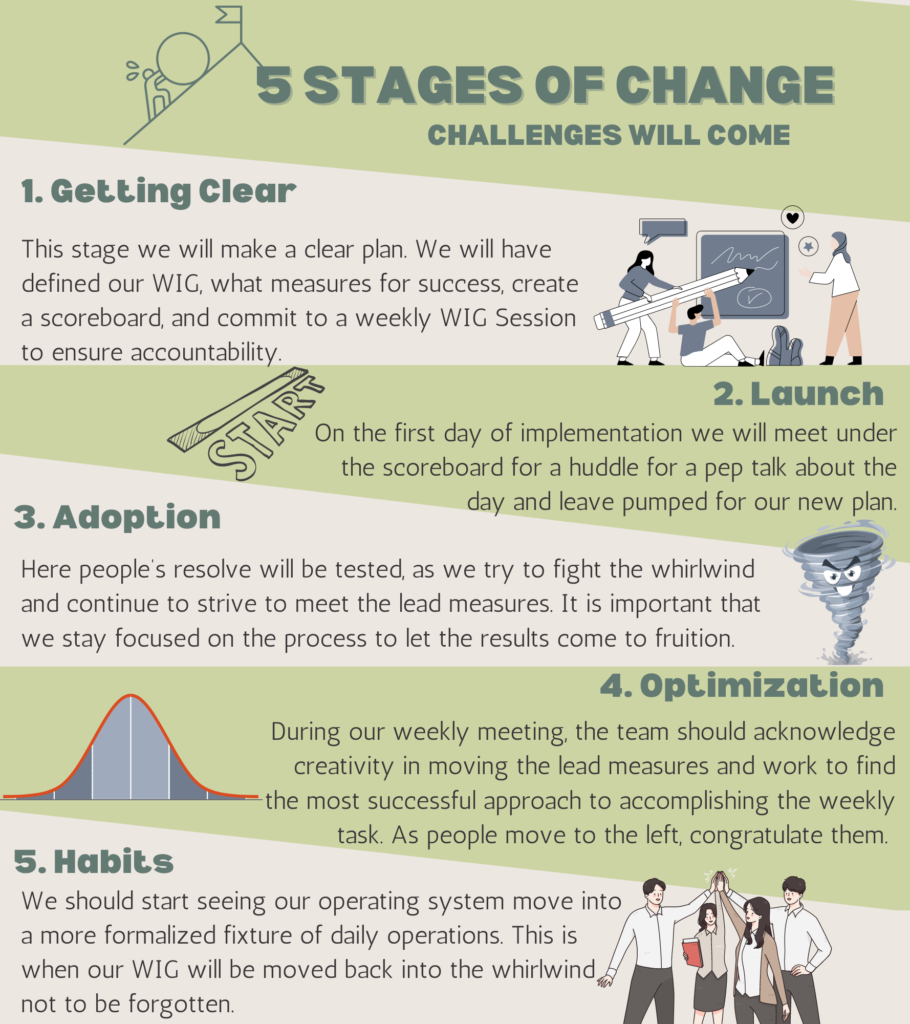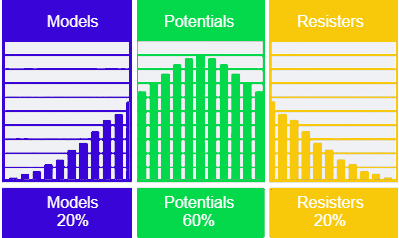
4DX – Gain the Ability to Follow Through
The 4DX plan will be used in two ways. First, I will use this plan to work with my team to get them on board with my innovation plan and create a learning environment that allows for control, ownership, voice, and an authentic learning opportunity. I will then add in some of the 4DX mixed with the Influencer Model to implement the process in my classroom. To start, I will approach the science department with a presentation over what I plan to install in the classroom, and ask for teachers that want to join me on this path of filling learning gaps for at-risk students. Once we have a team I will install the 4DX system using the following plan.
4DX – Implementation with Colleagues to Focus on Installing my Vision Plan in our Classrooms.
Discipline 1: Focus on the wildly important.
Concentrate your effort on a few goals, instead of trying to do everything at once. When selecting our goals, the team will need to focus on one or two goals that will move the scale the most. If we try to do too much at once we will most likely get none of them done. This is due to the fact that our daily work life will constantly drag us back in and we will lose focus. However, if we focus on one or two goals, we will be able to stay the course.
Discipline 2: Act on lead measures.
Each day the business of our daily work will draw us away from meeting our lead measures. So we will have to purposefully plan to accomplish the lead measures daily.
Discipline 3: Keep a Compelling Scoreboard.
Everyone must know how everyone is doing all of the time. To accomplish this we will need to make tracking sheets for each class with all the students’ names. The purpose of the tracking sheet will be two fold. First, each week we need to work with the students to ensure that they understand their goals for the week and have created their learning plan. Second, we need to monitor our daily interaction with each student. As we meet with each at risk student, we need to mark down that we accomplished the task. We will use this data to fill in the scoreboard weekly to show how successful we are with the engagement of our students.
Discipline 4: Create a Cadence of Accountability.
Each week the group must meet around the scoreboard to report on how successful they were at accomplishing the goals for that week. Then we will need to make a plan for the coming week. If anyone fails to meet their goals from the previous week. Then the group must hold them accountable and get guarantees on how they will accomplish the missed plans and how they will accomplish their new ones for the coming week.
STAGES OF CHANGE
Change is hard so challenges are expected. According to the authors of 4DX most teams go through five stages of behavior change. This is a general ideal of how I think the stages will unfold. I know that this area needs to be flexible as we implement the 4DX plan.

Stage 1: Getting Clear. This stage we will make a clear plan. We will have defined our most important goal, the WIG, what measures will be measured to ensure its success, create a scoreboard, and finally agree on a mandatory weekly WIG Session to ensure accountability.
My coworkers will probably balk at this concept, since many people believe more is better. Convincing them to narrow our focus will take some skillful discussions. I thought of possibly recommending the 4DX book to my work team, but I doubt they will read it. So my first plan is to explain how the program works. I really like the example of weight loss and think that I will use this example when teaching the concept to my colleagues. Once they understand, then we will come up with our goals to incorporate station rotation with blended learning in the classroom. Once we have a list we can focus on the most important goal. In my innovation plan, the goal is to fill the learning gaps of students that have been neglected. Unless they come up with a better goal, then our widely important goal (WIG) will be to: increase at risk students’ success on unit tests from failing to a 70 by the end of 9 weeks.
The battle begins, we will need to create the lead measures that will ensure victory of the WIG. I currently think this will be done through the students personalized learning plan. These plans will lay out a road map for our students that they will use to ensure they are learning the vital information to be successful. Our goal as teachers will be to first ensure that we focus the students on meeting their learning objectives and pass the knowledge checks, to secondly ensure that we are implementing the right thinking by encouraging our students’ effort and guiding them to proper understanding when they have not yet understood the concept. To that end, our lead measures will be:
1. work with all of the students to ensure they create their personalized learning plan each week.
2. Ensure that 100% of the at risk students have individual time with the teachers daily.
Stage 2: Launch. Ready, set, go…on the first day of implementation we will meet under the scoreboard for a huddle for a pep talk about the day and leave pumped for our new plan. I will need to stay focused as I am the model for my team. It will be easy to get sucked back into the whirlwind, but I need to trust the 4DX process and stay the course. Also, I will see what categories each of my team members fall into.
Stage 3: Adoption. Here people’s resolve will be tested, as we try to fight the whirlwind and continue to strive to meet the lead measures. It is important that we stay focused on the process to let the results come to fruition. This will be a shaky time as resistance will rear its ugly head. I will need to work with the resisters by answering all of their issues honestly and help them navigate this new process. I will also need to work with potentials, the individuals that want to successfully implement the 4DX plan but need help in accomplishing the task. As we work through the first few weeks. We may need to make adjustments in the plan, and this should be discussed in the weekly WIG meeting. Each week we will update our scoreboard and hold each other accountable for meeting our obligations, no exceptions.
This stage will hinge on the implementation of the station rotation process. During each station the students will have a specific task to complete with one station being a teacher station. This is where the teacher will check progress and clarify any misconceptions regarding the learned information or personalized learning plan. If the teacher is engaged in this station then they should meet both of the lag measures easily. However, time is limited and they may have difficulty managing their time in this station at first.

Stage 4: Optimization. During our weekly meeting, the team should acknowledge creativity in moving the lead measures and work to find the most successful approach to accomplishing the weekly task. As people move to the left, congratulate them.
To help with time management, teachers should prepare for their station the day before by reviewing each student’s scores on their knowledge check. This way they can identify the students that did not understand the material and can counsel them. They should also keep track of each student’s learning objectives for the week and forecast the students PLP for the following week. This way they can ensure they are ready weekly to assist each student in drafting their PLP. I am sure that as we progress the team will find ways to streamline this process that had not been considered.
Stage 5: Habits. During this stage we will have achieved the WIG. We should start seeing our operating system move into a more formalized fixture of daily operations. This is when our WIG will be moved back into the whirlwind not to be forgotten, but the habits we have formed will remain and we can move on to another WIG.
How the Influencer Model and 4DX complement/supplement each other.
The Influencer Model and 4DX are so similar that I mixed them up constantly at first. After a few weeks I understood that even though they both touch base on the same concepts the 4DX quantified the measures, whereas the Influencer Model did not. I also felt that the influencer model was more for the individual to change and have the organization follow, whereas the 4DX model was a team focused process. Honestly, they are so complementary that they should be used together. In the 4DX model, we want organizational change, but to accomplish that change we need the individuals to change themselves to accomplish the organization’s goals. The Influencer Model, shows how one individual can influence others around them to make changes and accomplish things they never would have believed possible.
References
Grenny, J. (2013). Influencer: The New Science of Leading Change. McGraw-Hill Education.
Huling, J. (2012). 4 Disciplines of execution – achieving your wildly important goals. Simon & Schuster.






One Comment
Tania Barrientos
Implementing your plan via the 4DX process demonstrates an in-depth understanding of the disciplines promoted by its creators. I am sure that even if some resistance comes along or adjustments need to be made, your innovation plan will succeed.